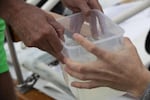It's not unusual for toxic algal blooms to close a lake or pond. And in recent years, these algae have been contaminating another type of swimming spot: the Willamette River. In early August, the Oregon Health Authority advised Portland residents to keep themselves and their pets out of the water in certain areas.
Such warnings have become increasingly common along Portland’s stretch of the Willamette, and most of the blooms have been traced back to one location: the lagoon on Ross Island just upstream of downtown Portland. The Human Access Project, an organization that aims to get more Portland residents swimming in the river, wants to change the nature of Ross Island lagoon to prevent blooms like this in the future.
Thanks to restoration efforts, Ross Island is a small oasis in the middle of the Willamette. It hosts populations of deer, riparian forests and dozens of types of birds.
But the lagoon has all the things toxic algae needs to thrive, according to Dr. Theo Dreher, a microbiologist at Oregon State University. These blooms are caused by cyanobacteria, or blue-green algae, which live best in warm, stagnant, nutrient-rich water. The lagoon is all three.
“The bacteria grow in the lagoon, like a lake. But they can be swept out through a passage downstream, where they can remain viable for quite a long time,” Dreher said.

Cells of cyanobacteria, also known as blue-green algae, contaminate the water in Ross Island Lagoon. A recent algae bloom caused Oregon Health Authority to issue a health advisory.
Miranda Daviduk / OPB
It's the same type of phenomenon that contaminated Salem's water earlier this summer: Cells from a toxic algal bloom in Detroit Lake flowed down the Santiam and into the city's water.
Related: As Salem Frets About Toxic Algae, Should The Rest Of Oregon?
According to the Oregon Health Authority, there have been a few small blooms linked to other areas on the Willamette over the years. But none of those blooms have produced enough toxins to lead to a health advisory. The lagoon at Ross Island, however, has created severe blooms four out of the last five years. Those blooms have been linked to record-high temperatures in the air and in the river, and low snowpack in the Cascades.
Once there’s been a major bloom in the area, Dreher said, you’re more likely to get another. Some cyanobacteria survive the winter, waiting for the right conditions to bloom again. And climate change is expected to make those conditions occur more frequently.
Willie Levenson, whose official job title is ringleader of the Human Access Project, is concerned that the blooms could get large enough to make summer river swims a thing of the past.
“It’s possible blooms could start in the spring and last all summer, if we don’t do something,” Levenson said.

Willie Levenson is known to advocate for recreating in the Willamette river. He is also board member of the Human Access Project, an organization working to reshape public perception of the river.
Miranda Daviduk / OPB
He’d like to see water circulation restored to the Ross Island lagoon, which did not always exist. It was created in 1926, when the U.S. Army Corps of Engineers built a levee between Ross and Hardtack islands, cutting off much of the water circulation.
“Maybe we could build a channel, or put in pumps or a fish passage,” Levenson suggested.
Dreher said getting the stagnant water moving probably would stop the blooms, because cyanobacteria don’t reproduce well in moving water.
Doing so would require cooperation from multiple actors. The Ross Island lagoon is listed as a contaminated site by the Oregon Department of Environmental Quality. For the last several years, Ross Island Sand and Gravel capped and cleaned known contaminated sites, and began restoring the lagoon by filling in parts of a 300-foot-deep mine site.
Any effort to restore water circulation couldn’t conflict with Ross Island Sand and Gravel’s restoration orders, according to Randy Steed, the company’s president and chief operating officer.

A water sample is taken from the Ross Island Lagoon to closely see blue-green algae.
Miranda Daviduk / OPB
Steed said the company is open to suggestions, as long as they fit within the constraints of their operating permits. But, he noted, any cooperation with the Human Access Project is in very early stages. According to Steed, “we haven’t even spitballed any plans yet.”
Additionally, the company does not control the entire island system: It only operates on the north end of the island. Other parts of the island are owned by the city of Portland and maintained as green space.
In the meantime, the Oregon Health Authority continues to monitor the Willamette for toxic algae. Currently, there are no detectable levels of cyanobacteria-caused toxins outside of Ross Island lagoon, and the health authority has updated their advisory to reflect this. But summer isn’t over, and the water in the lagoon is still dotted with bright green colonies. The bloom could come back, and the river could become unsafe to swim in again.
Correction: Aug. 20, 2018. This story initially misidentified the owners of Ross Island. The ownership is split between Ross Island Sand and Gravel and the City of Portland.
